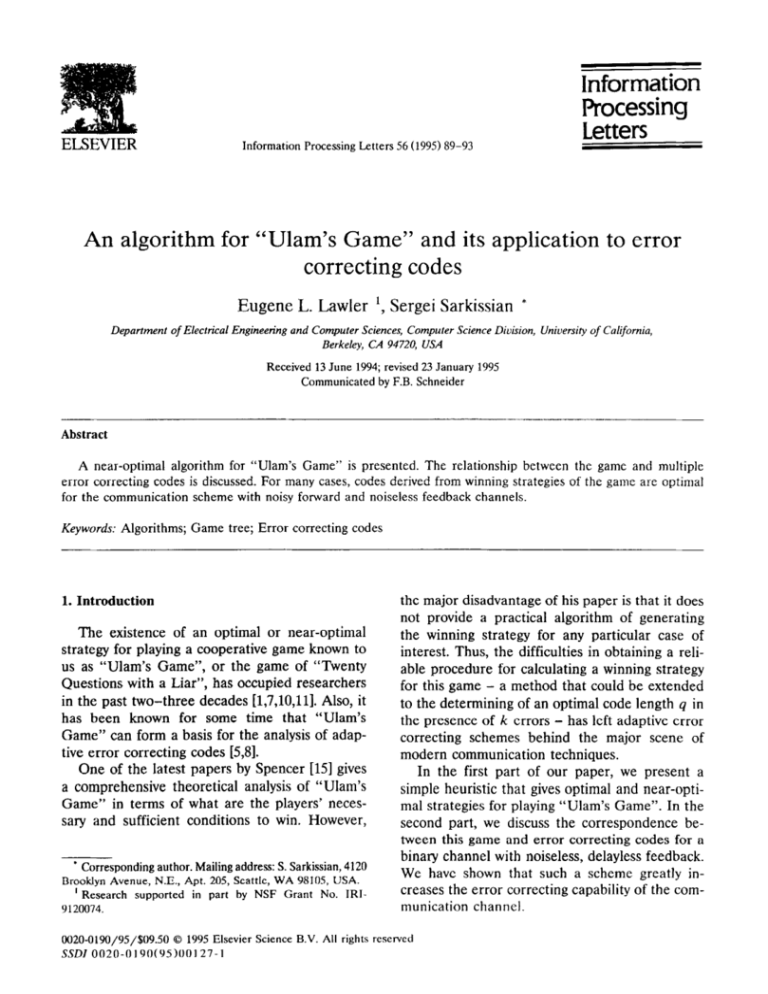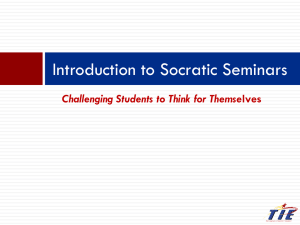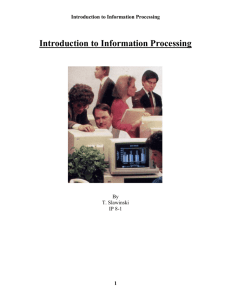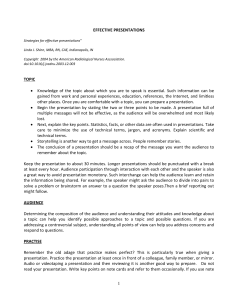
ELSEVIER
Information
Information
Processing
Letters
Processing Letters 56 (1995) 89-93
An algorithm for “Ulam’s Game” and its application to error
correcting codes
Eugene
Department
L. Lawler
I, Sergei Sarkissian
*
of Electrical Engineering and Computer Sciences, Computer Science Division, Universiw of California,
Berkeley, CA 94720, USA
Received 13 June 1994; revised 23 January
Communicated
by F.B. Schneider
1995
Abstract
The relationship
between the game and multiple
A near-optimal
algorithm for “Ulam’s Game” is presented.
error correcting codes is discussed. For many cases, codes derived from winning strategies of the game are optimal
for the communication
scheme with noisy forward and noiseless feedback channels.
Keywords:
Algorithms;
Game tree; Error correcting
codes
1. Introduction
The existence of an optimal or near-optimal
strategy for playing a cooperative game known to
us as “Ulam’s Game”, or the game of “Twenty
Questions with a Liar”, has occupied researchers
in the past two-three decades [1,7,10,11]. Also, it
has been known for some time that “Ulam’s
Game” can form a basis for the analysis of adaptive error correcting codes 1581.
One of the latest papers by Spencer [15] gives
a comprehensive theoretical analysis of “Ulam’s
Game” in terms of what are the players’ necessary and sufficient conditions to win. However,
l
Corresponding
Brooklyn
’
Avenue,
Research
author. Mailing address: S. Sarkissian, 4120
N.E., Apt. 205, Seattle,
supported
in part
by NSF
9120074.
0020-0190/95/$09.50
0 1995 Elsevier
SSDI 0020-O 19O(Y5)001271
WA 98105, USA.
Grant No. IRI-
the major disadvantage of his paper is that it does
not provide a practical algorithm of generating
the winning strategy for any particular case of
interest. Thus, the difficulties in obtaining a reliable procedure for calculating a winning strategy
for this game - a method that could be extended
to the determining of an optimal code length q in
the presence of k errors - has left adaptive error
correcting schemes behind the major scene of
modern communication techniques.
In the first part of our paper, we present a
simple heuristic that gives optimal and near-optimal strategies for playing “Ulam’s Game”. In the
second part, we discuss the correspondence between this game and error correcting codes for a
binary channel with noiseless, delayless feedback.
We have shown that such a scheme greatly increases the error correcting capability of the communication channel.
Science B.V. All rights reserved
90
E. L. Lander, S. Sarkissian /Information
2. A strategy for playing “Ulam’s Game”
In the game of “Twenty Questions with a
Liar”, one person (the Responder) thinks of a
“target” object and the other person (the Questioner) attempts to identify the target by asking
questions that can be answered “yes” or “no”. If
the Responder stipulates that the target is an
integer in the interval [l, . . . , N], then it is easy to
see that a bisection search enables the Questioner to identify the object in [log,N] questions.
Furthermore, an adversary argument shows that
no smaller number of questions will suffice in the
worst case.
The Responder is permitted to answer as many
as k questions with lies, where k is a number
agreed upon in advance by the players. S.M.
Ulam posed a special case of this game in his
autobiography, Adventures of a Mathematician
[17]. Hence the present name of the problem “Ulam’s Game”.
The Questioner can ask any question of the
type: “Is the target a member of the set S?“,
where S c (1,. . . , N}. The state of knowledge of
the Questioner at any point in the game is given
by a collection of disjoint subsets, A,,, A,, . . . , A,,
where A,UA,U
... UA,c{l,...,N)
and
where Ai is the subset of possible targets under
the condition that the Responder has told exactly
i lies (i = 0, . . . , k). For example, suppose N = 4
and k = 1. If the Questioner initially asks “Is the
target in the set {1,2}?” and the Responder answers “yes”, then A,, = (1, 2) and A, = {3, 4). A
complete game tree, in which the target can be
Processing Letters 56 (199.5) 89-93
identified in five questions (a worst-case optimal
number) is given in Fig. 1.
It is not hard to verify that in order for the
Questioner to win, N, q and k must satisfy the
inequality
Spencer [ll] has shown that, when q is sufficiently large, the Questioner can always win the
game in q questions, if
Ni:
q + Ckqk < 24,
j=o 0
k
where ck is a constant depending on k. However,
since this is an asymptotic result, it is not of much
help in verifying the existence of winning strategies for specific values of N, q and k. However,
we have found that a simple heuristic yields a
nearly optimal strategy for the Questioner. We
have used his heuristic to confirm the existence of
winning strategies, as described below.
Suppose the state of knowledge of the Questioner is (A,, A,, . . . , Ak), with r questions remaining to be asked. Let us define the “weight”
of the state (A,, A,, . . . , A,) as
wr(A,,
A,,...,A,)
where for notational convenience,
(:J=(;)+(;)+-+(;).
l1.2,3.41
By generalization of Cl), it must be the case that
~@a, A,,. ..,. A,) Q 2’, in order for the Questioner to be able to win the game. Hence the
Questioner is constrained to pose a question for
which the states (Y,, Yi, . . . , Yk) and (NO,
N i,. . . , Nk) resulting from “yes” and “no” answers are such that
wr_,(Yo, Y,,.. .,Y,) <2’-‘,
Fig. 1. All numbers in the sets A,, are denoted
the sets A, as (*)‘.
as {*)
and in
wr_,( No, N,,. . . , Nk) < 2’-‘,
E. L. Lawler, S. Sarkissian /Information
and
wr( A,, A,, . . . >Ak)
=w,_,(Y,,
Y, ,...,
Y,) +w,-,(&,
N,,...,&)?
for any possible question that may be posed.
Hence the Questioner would seem to be well
advised to pose a question for which w,._,(Y,,,
Yr,. . . ,Yk) and w,_,(N,, N,, . . . , Nk) are as nearly
equal as possible. Let S = S, U S, U . . . U S,,
where Sj GA,, be a set about which a question is
asked, and let
Ys =
r-1
k
i
1
&I+
-** + r;l
(
1
IS,1
Processing Letters 56 (I 995) 89-93
91
Therefore, to verify how close the results of
our heuristic are to the actual optimal solutions,
we have generated a number of instances for
which the algorithm is able to find winning strategies for the Questioner in the smallest number of
questions satisfying the sphere-packing inequality. In Table 1 we have indicated, for given k and
i, where N = 2’, the smallest number of questions
for which the heuristic found a winning strategy
for the Questioner. When this number is greater
than the minimum number satisfying the spherepacking inequality, the latter number is indicated
in parentheses.
and
1
y
IA,\S,l+
i
As Spencer observed,
n
S=
IW,_,(Y”, Y,,...,
3. “Ulam’s Game” vs. error correcting codes
**. +jr$4,\s,I.
Y,) -w,_,(N,,
N,,...,N,)
I
= IYs-n,l.
Accordingly, our heuristic is very simple:
Choose_S (A,, A ,,...,
y,:=n,:=
A,, r>
0;
for j = 0 to k
Choose Sj to minimize
n, := n, + (;-,!>I Aj\Sj
1;
endfor
return (Se, S,, . . . , S,);
end Choose _ S
It is necessary to note that Eq. (1) is analogous
to the well-known sphere-packing inequality for
(nonadaptive) k-error correcting codes [4]. Except that here the sum represents the number of
root-to-leaf paths that must exist for each of the
N possible target objects in a game tree of height
q, rather than the number of code words in a
sphere of radius k.
Suppose the Transmitter is to encode i information bits for transmission to the Receiver, with
provision for the correction of at most k errors.
The Transmitter assumes the role of Responder
and the Receiver the role of Questioner, the two
parties playing the game cooperatively, making
reference to the same game tree. The Receiver,
in the role of Questioner, must guess the correct
target out of a set of size N = 2’. The Transmitter, in the role of Responder, anticipates the
questions that the Receiver wishes to ask. Each
error that occurs in the transmission amounts to a
lie told by the Responder, and the Transmitter
knows this by comparing the signal sent in the
forward channel to the signal received from the
feedback channel.
The target is one of the N = 2’ bit patterns,
o...o to 1 . . . 1. We propose to predetermine the
first i questions that are asked. Question j, 1 <j
G i, is: “Is bit position j of the target pattern a
l?“. Thus the Transmitter simply transmits the i
information bits in answer to these first i questions, thereby making the code systematic, i.e.,
one having distinct information bits and check
bits. After the i information bits have been transmitted, the state of the knowledge of the Receiver is (A,,, A,, . . , Ak), where
IAjI
=
0!
.I
1
;=o
)..”
k.
E. L. Lawler, S. Sarkhian /Information
92
By reference to the feedback channel, the
Transmitter records the sequence of bits actually
received by the Receiver. The Transmitter exclusive-or’s this sequence with the sequence of bits
actually sent, thereby obtaining an error pattern.
There are exactly 1Aj I possible error patterns for
j transmission errors, for j = 0,. . . , k, for a total
of ( ik) patterns. The Receiver is able to determine the target pattern if and only if the Transmitter can inform the Receiver of the correct
error pattern with the 4 -i check bits that remain to be transmitted.
Remarkably, our heuristic gives results that
very much correspond to the relation established
by Berlekamp [2]. According to his “translation
bound theorem”, the optimal code length for the
transmission of a message containing i information bits through the channel where k errors may
occur differs from that for the transmission of the
same message through the noisy channel with
k - 1 possible errors in three additional
check
bits. Table 1 shows that only in three cases,
nameIy, for 8, 11, and 14 information bits, the
violation is observed. For example, in the case of
8 information bits and 5 errors, the algorithm has
generated the code length of 25 bits. However,
the translation rule predicts only 24 bits for the
Table
i
optimal code length. In all other instances, the
heuristic has produced optimal solutions.
Most importantly, the above results provide
good example of the usefulness of the feedback
channel in communication schemes. The fact that
a sequential recursive coding strategy increases
transmission efficiency is well documented in the
literature [3,5]. Schalkwijk and Post [14] also
showed that in a binary symmetric channel with
noiseless feedback code digits can be decoded in
such a way that the error probability vanishes
exponentially even for a fixed coding delay. More
recently Spencer and Winkler [16] observed that
without a feedback channel no block code can
correct for more than [q/41 errors, when the
number of information bits is sufficiently large.
With a feedback channel, it is possible to correct
as many as [q/31 errors for any number of information bits i. (Note, however, that some coding
schemes for two binary forward channels allow
one to achieve essentially the same efficiency in
communication as it would be in the presence of
feedback channel [14].) Also, in comparison with
the best known multiple-error correcting linear
codes (e.g., BCH codes) [6,9], the improvements
in error correcting capability are achieved for
i a 3 and k > 2 with a few exceptions.
1
k
1
1
2
3
4
5
6
7
8
9
10
11
12
13
14
1.5
16
Processing Letters 56 (1995) 89-93
3
5
6
7
9
10
11
12
13
14
15
17
18
19
20
21
2
3
5
S(7)
9
10
12
13
14
15
17
18
19
20
21
22
24
25
7
1100)
12(11)
13
1504)
16
17
18
20
21
22
23
25
26
21
28
4
5
1402)
15(14)
11
17(14)
lB(16)
9
1605)
1807)
1908)
20
21
23
24
25
27
28
29
30
32
1908)
21(20)
22(21)
23
25(24)
26
27
28
30
31
32
34
3.5
6
I
8
13
15
17
20(16)
21(18)
22(20)
24(22)
2308)
24(21)
26(21)
27W
28(25)
25(24)
26(25)
28(27)
2928)
30
32(31)
33
34
35
37
38
25W
27(25)
28(26)
29(28)
31(30)
32(31)
33
3504)
36
37
39138)
40
41
30(27)
31(29)
32(31)
34(32)
35(34)
36(35)
38(37)
39(38)
40
42(41)
43
44
E.L. Lawler, S. Sarkissian /Information
4. Implementation
As noted in the previous section, the first
phase of transmission is a straightforward, nonadaptive transmission of i information bits. In
particular, this means that unlike multiple repetition coding [2] our scheme allows bit subsequences of any form. In the second phase of the
transmission, during which check bits are transmitted, the Transmitter makes reference to a
fully worked out game tree. This tree has height
4 - i. A bit vector of length ( : k) is stored at each
node of the game tree with each component of
the bit vector corresponding to a different error
pattern. Suppose component h is identified with
the error pattern to be communicated to the
Receiver. When the Transmitter has arrived at a
given node of the tree, it transmits the bit found
in component h of the vector at that node. The
Transmitter observes the bit returned by the
feedback channel and proceeds to the child of
the current node, as specified by the bit returned.
Thus, only a few machine language instructions
need to be executed for each successive check bit
transmitted.
One of the advantages of implementing leftto-right decoding strategy presented here is that
in practice it is very likely that the Receiver will
be able to decode the transmitted message before
the last bit of the error pattern is received. In the
contrast to that, simple block coding strategies
developed by Schalkwijk [12] lead to the reverse
(right-to-left) direction of decoding: this implies
that the whole codeword must be scanned every
time.
In addition, it is observed that for a given
number of information bits the actual size of a
game tree as a percent of the upper bound decreases as the number of errors to be corrected
increases. For instance, an g-error correcting code
with 6 information
bits requires only 21.2
Processing Letters 56 (199.5) 89-93
93
megabytes of storage, which corresponds to about
8.3% of the upper bound of 256 megabytes.
References
[l] J.A. Aslam and A. Dhagat, Searching in the presence of
linearly bounded errors, in: Proc. 23rd Ann. ACM Symp.
on the Theory of Computing (1991).
[2] D.W. Becker, Multiple-repetition feedback coding, Ph.D.
Thesis, University of California, San Diego, 1973.
[3] E. Berlekamp, Block coding for the binary symmetric
channel with noiseless, delayless feedback, in: Error Correcting Codes (1968) 61-85.
[4] R.E. Blahut, Theory and Practice of Error Control Codes
(Addison-Wesley, Reading, MA, 1983).
]5] M. Horstein, Sequential transmission using noiseless
feedback, IEEE Trans. Inform. Theory 9 (1963) 136-143.
[6] F.J. MacWilliams and N.J.A. Sloane, The Theory of Error-correcting Codes, Part II (North-Holland,Amsterdam,
1977).
[7] A. Pelt, Solution of Ulam’s problem on searching with a
lie, J. Combin. Theory Ser. A 44 (1987) 129-140.
[8] A. Pelt, Detecting errors in searching games, J. Combin.
Theory Ser. A 51 (1989) 43-54.
[9] W.W. Peterson, Encoding and error-correction procedures for the Bose-Chaudhuri codes, IRE Trans. inform.
Theory 6 ( 1960) 459-470.
(101 B. Ravikumar and K.B. Lakshamanan, Coping with
known patterns of lies in a search game, Theoret. Comput. Sci. 33 (1984) 85-94.
[ll] R.L. Rivest, A.R. Meyer, D.J. Kleitman and K. Winklmann, Coping with errors in binary search procedures, 1.
Comput. System. Sci. 20 (1980) 396-404.
1121J.P.M. Schalkwijk, A class of simple and optimal strategies for block coding on the binary symmetric channel
with noiseless feedback, IEEE Trans. Inform. Theory 17
(1971) 283-287.
1131J.P.M. Schalkwijk, A coding scheme for duplex channels,
IEEE Trans. Comm. 22 (1974) 1369-1373.
[14] J.P.M. Schalkwijk and K.A. Post, On the error probabil-
ity for a class of binary recursive feedback strategies,
IEEE Trans. Inform. Theory 19 (1973) 498-511.
[15] J. Spencer, Ulam’s searching game with a fiied number
of lies, Theoret. Comput. Sci. 95 (1992) 307-321.
1161 J. Spencer and P. Winkler, Three thresholds for a liar,
Combin. Probab. Comput. 10992) 81-93.
1171 S. Ulam, Adventures of a Mathematician (Charles Scrib-
ner’s Sons, 1976).






